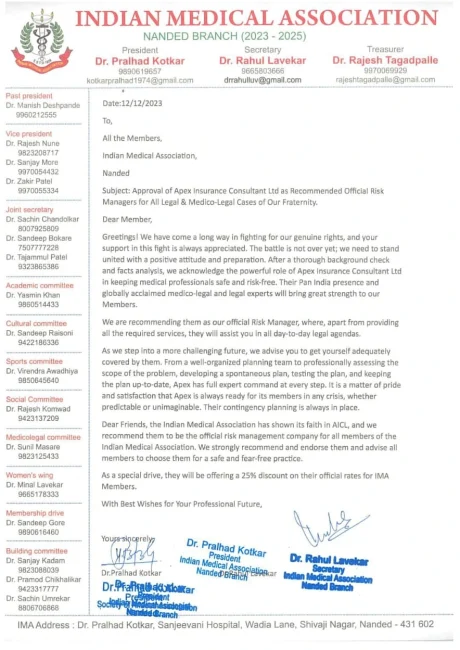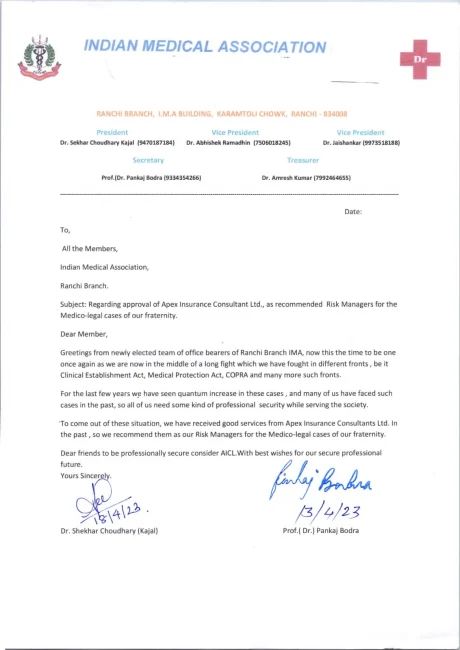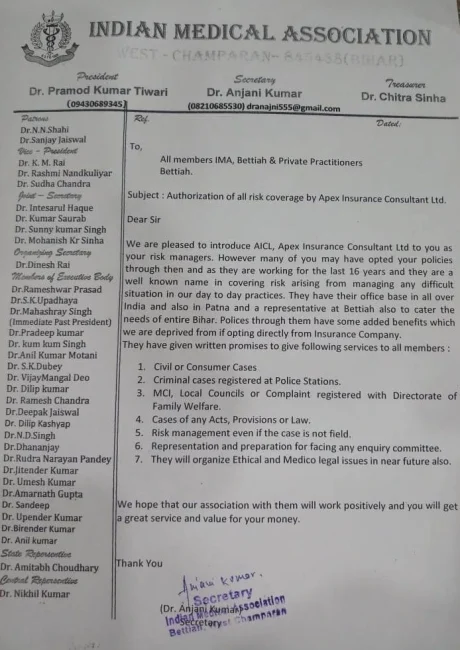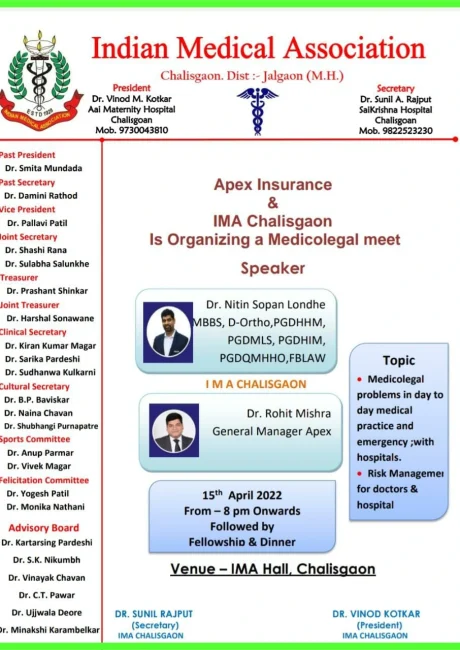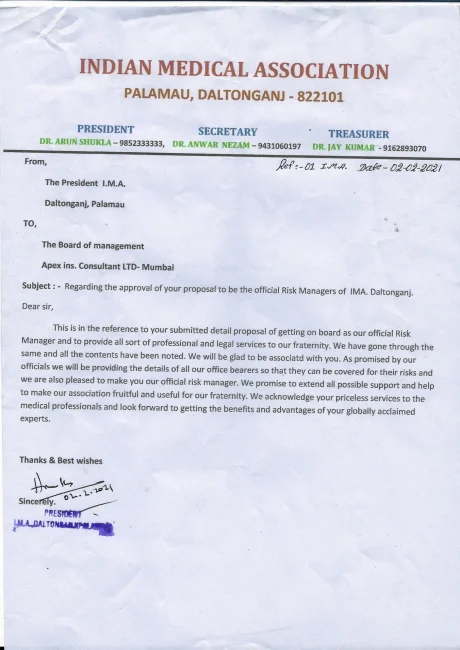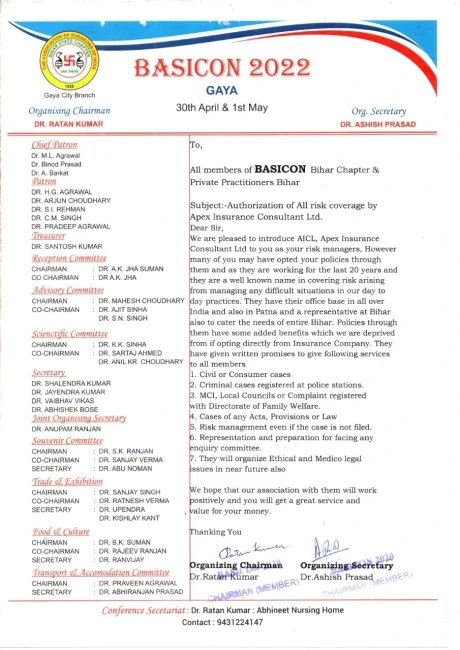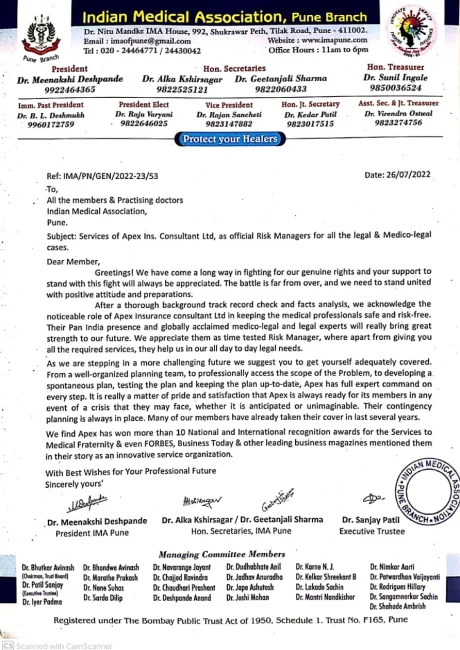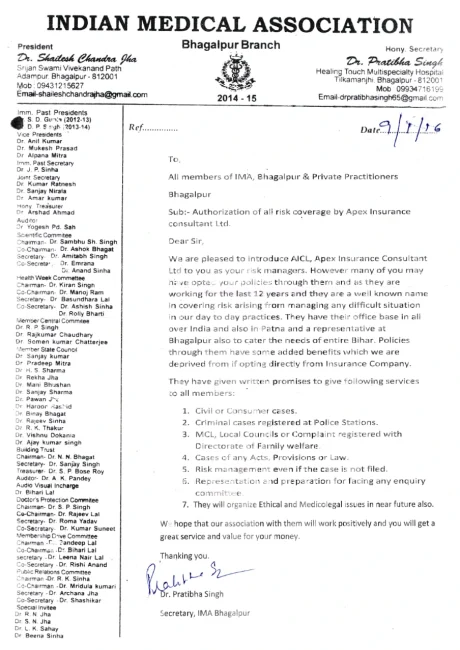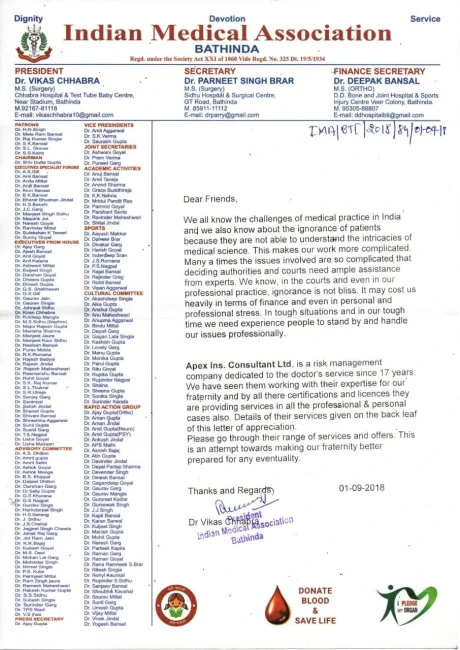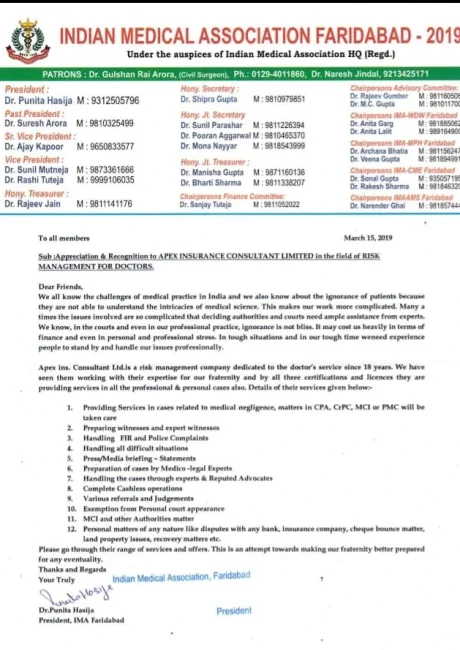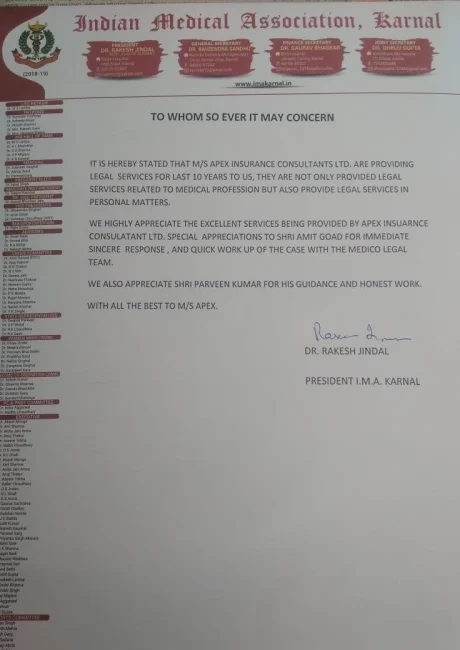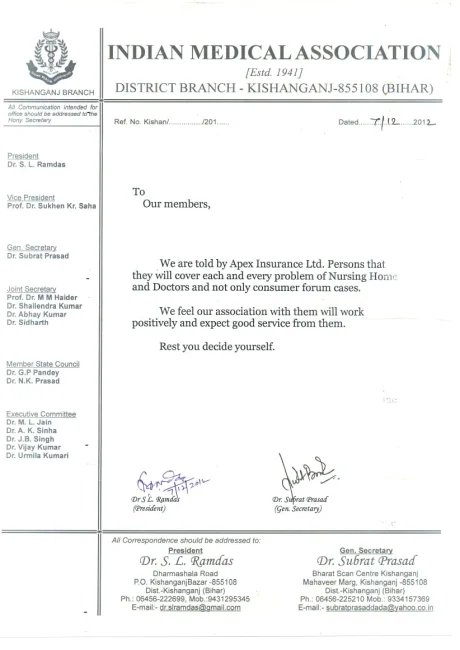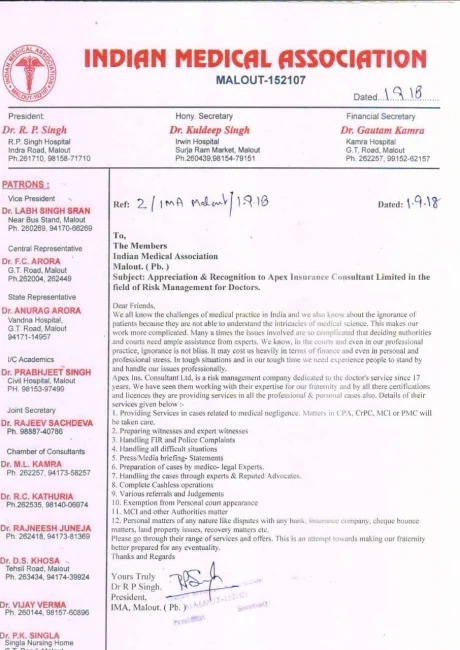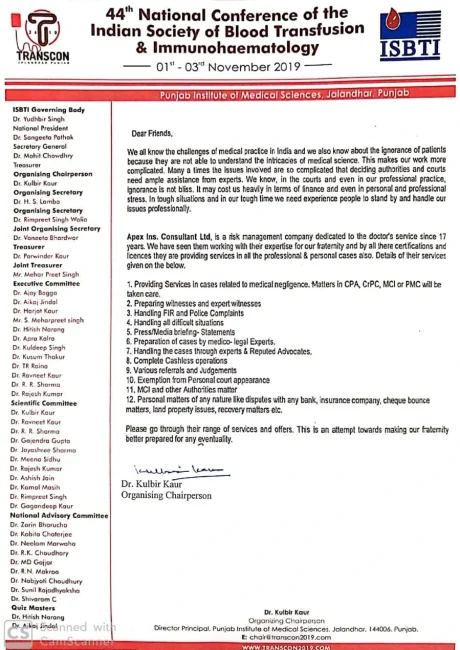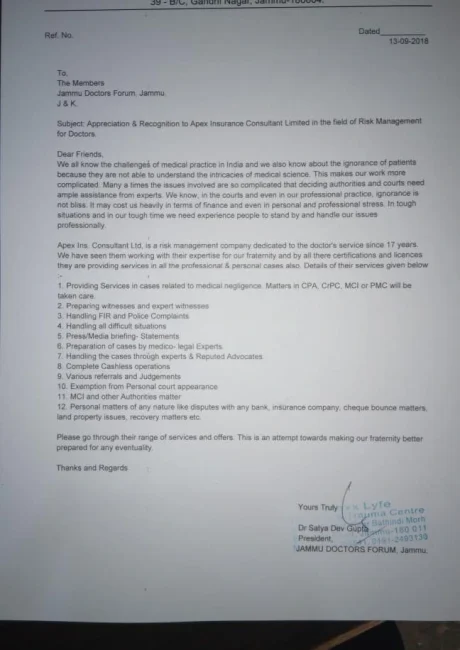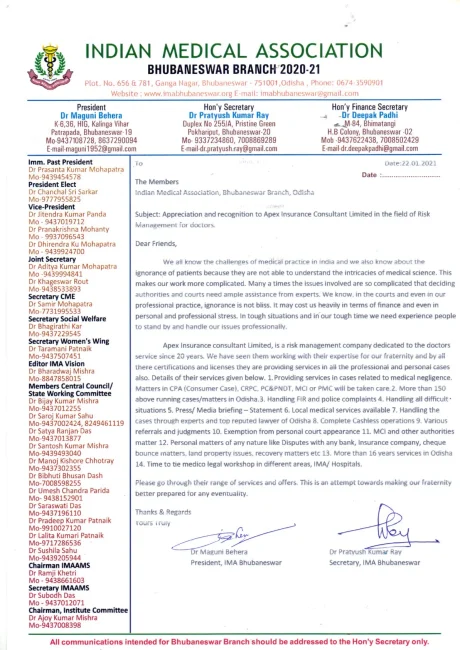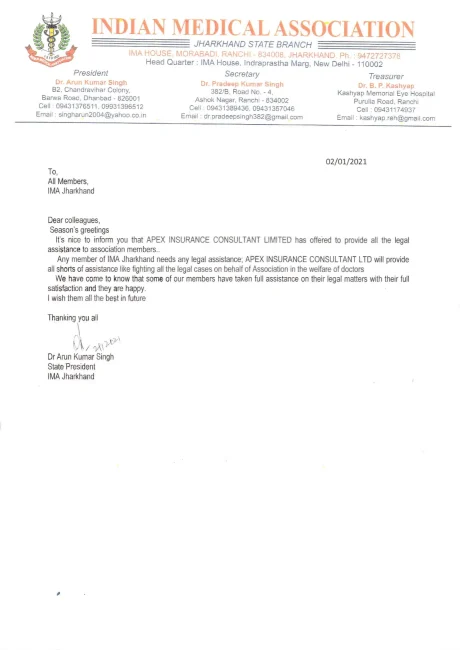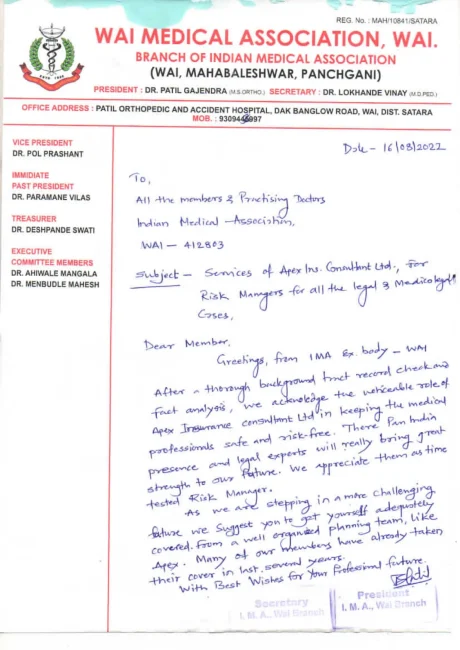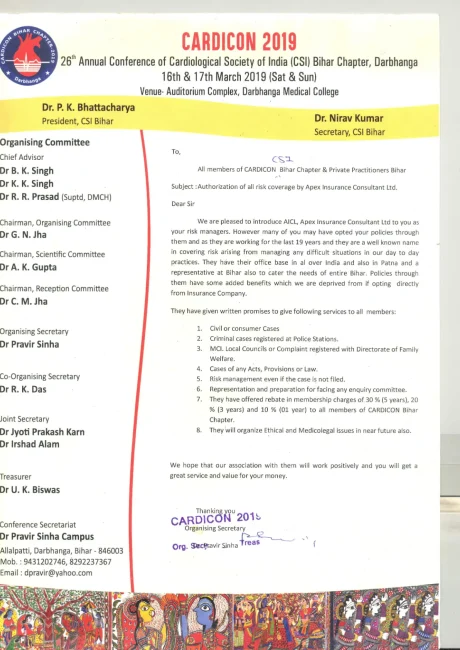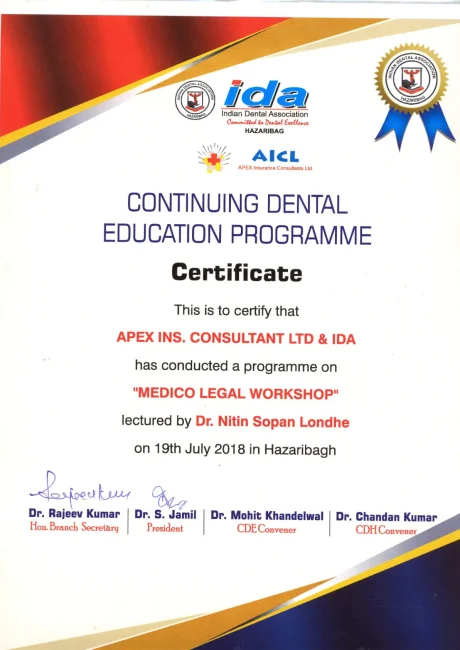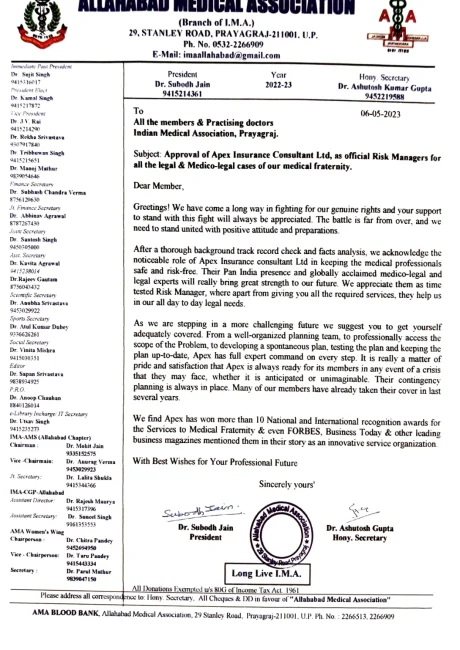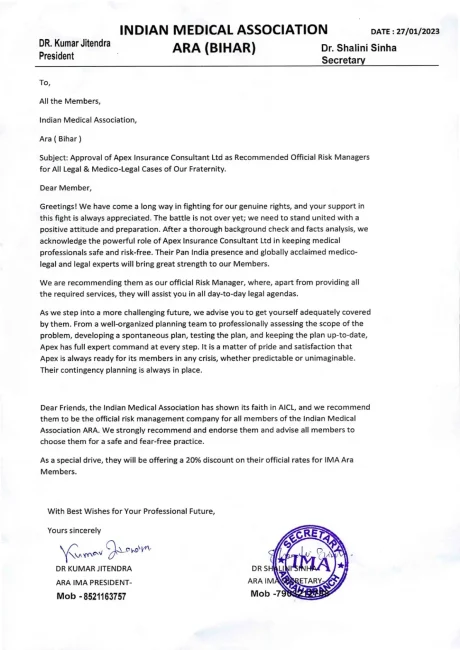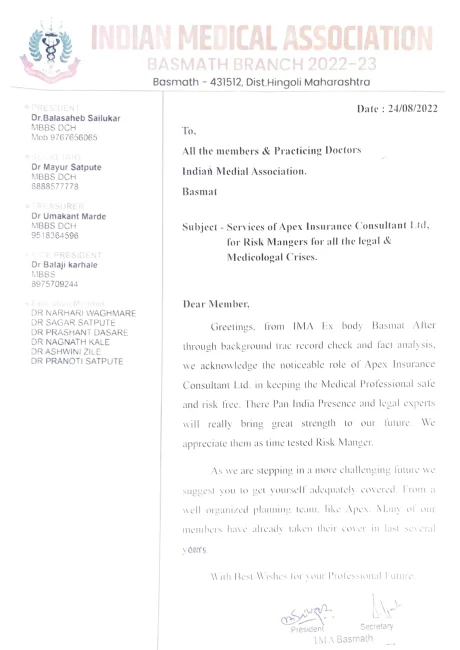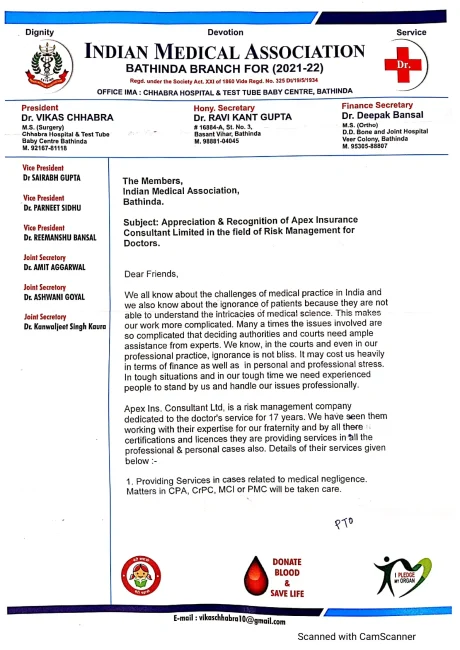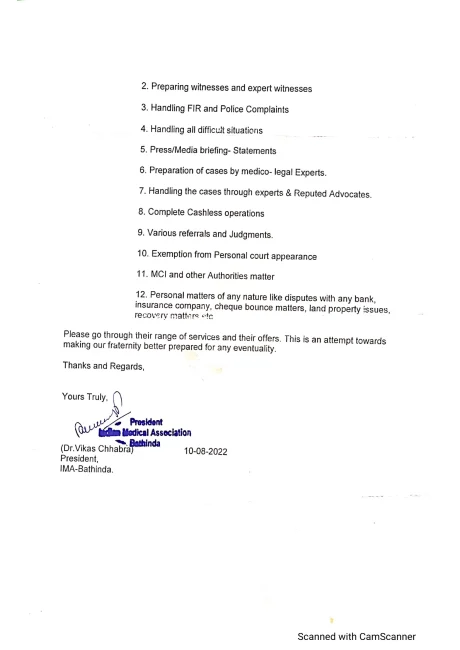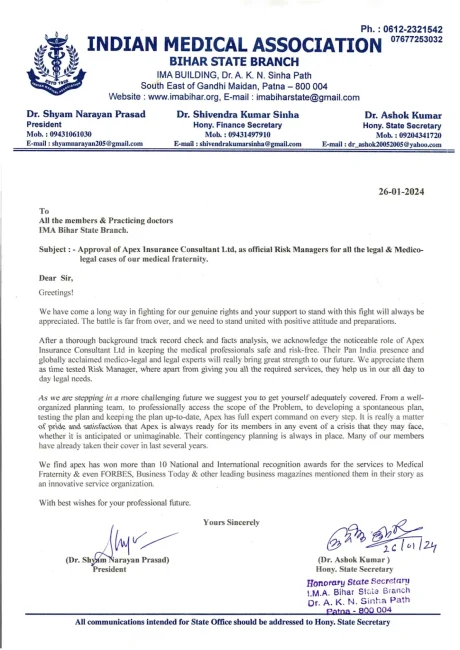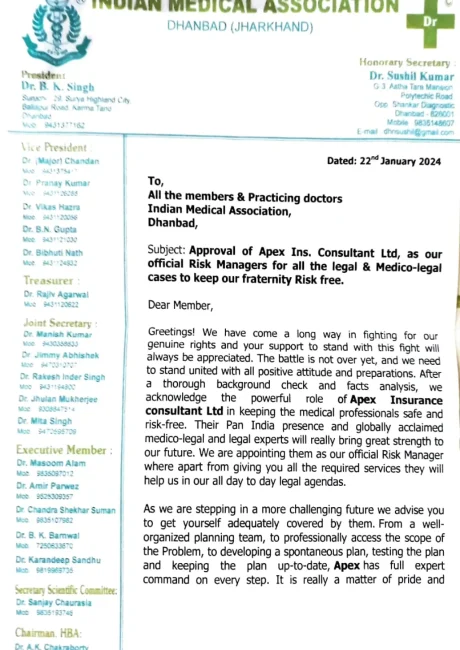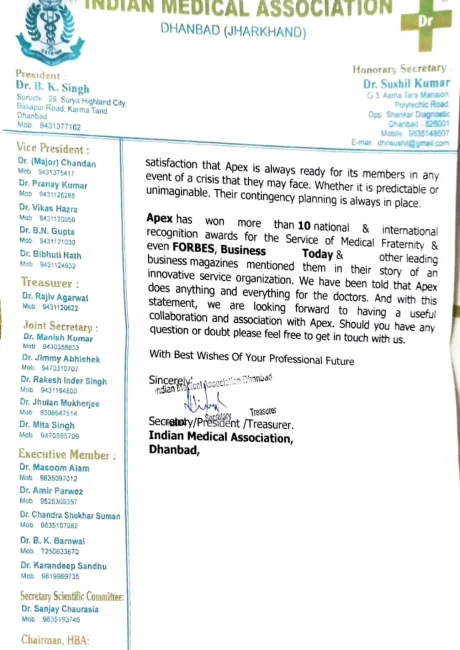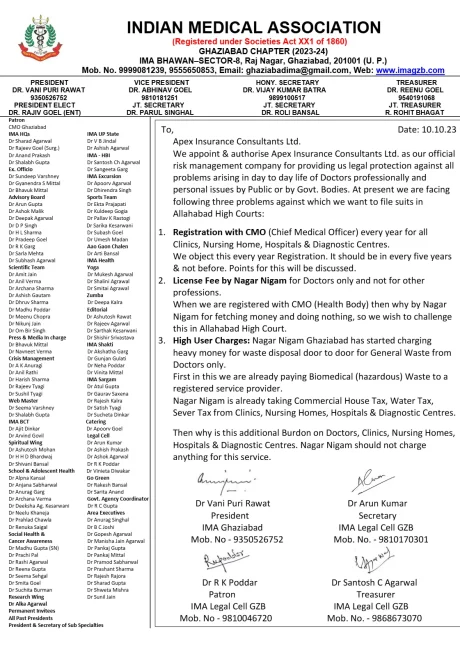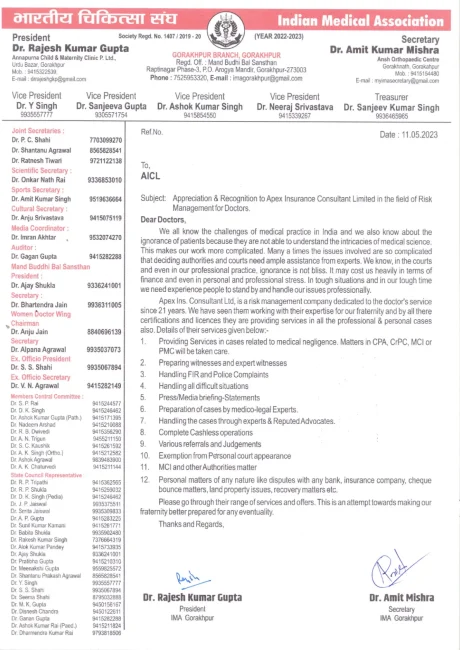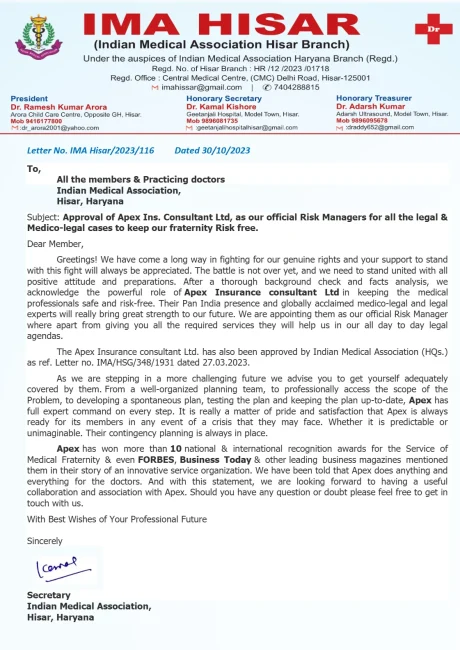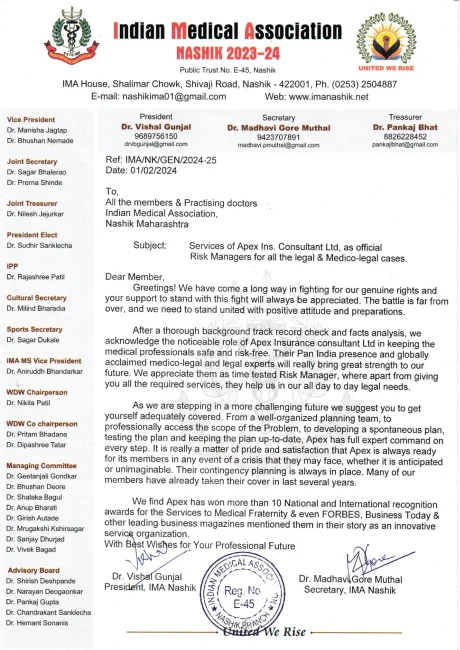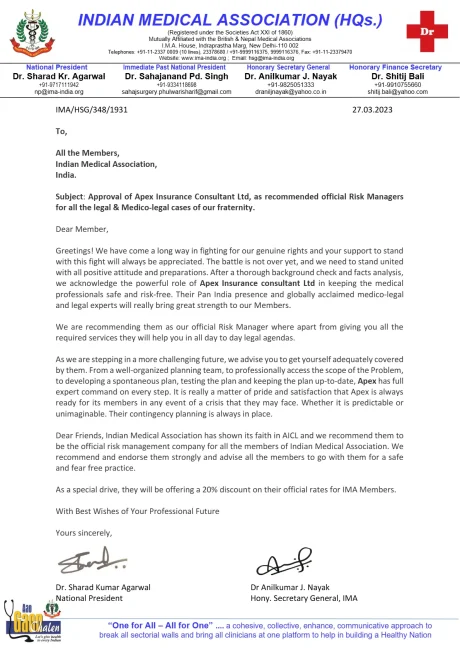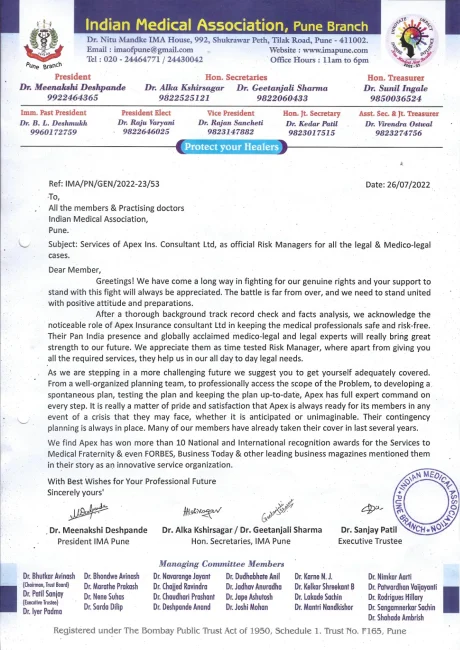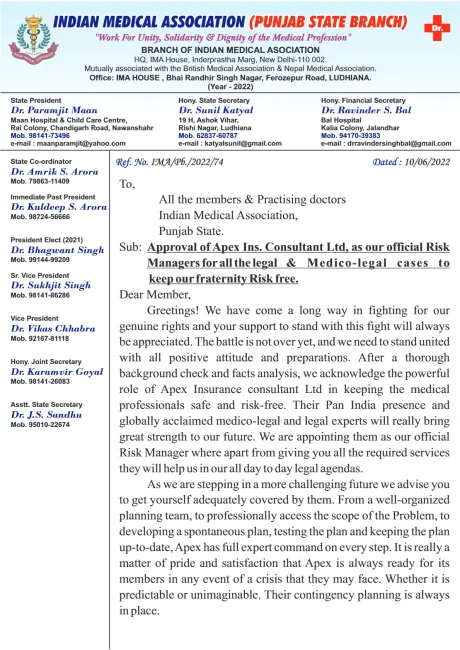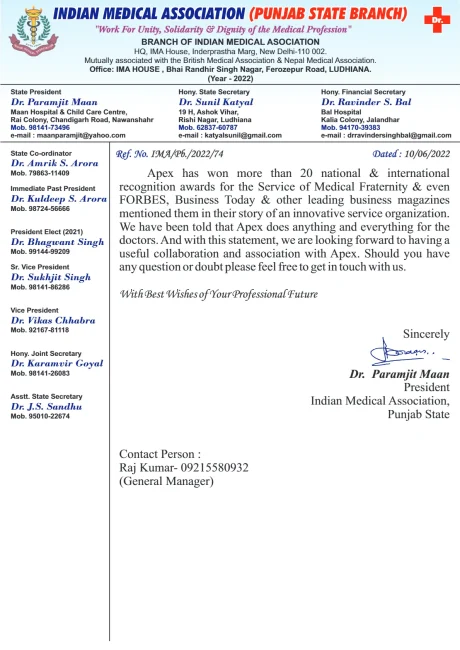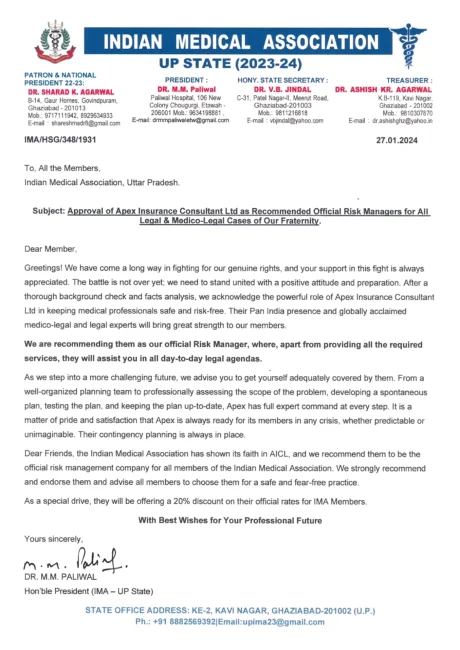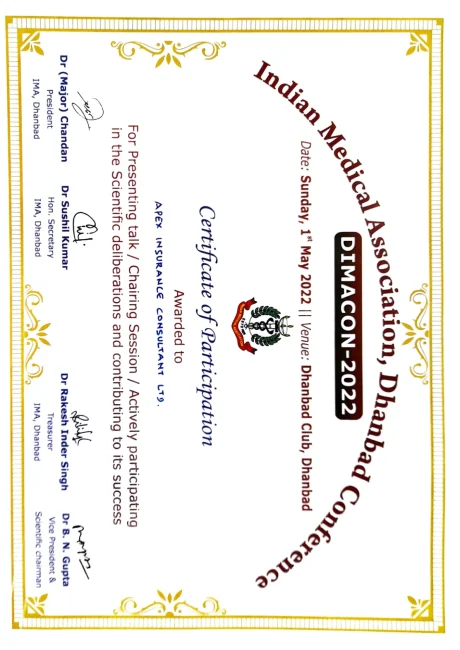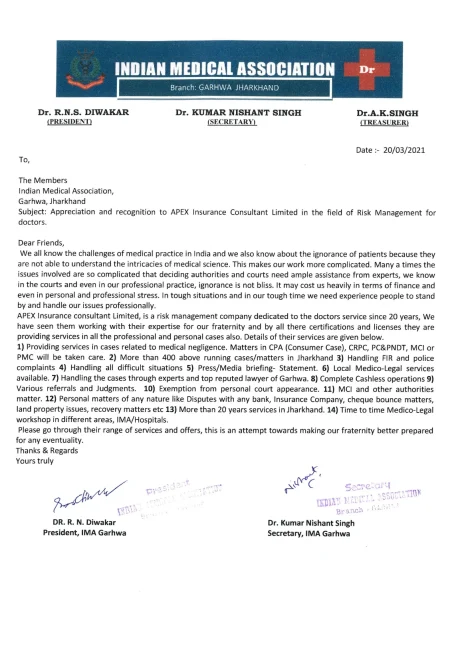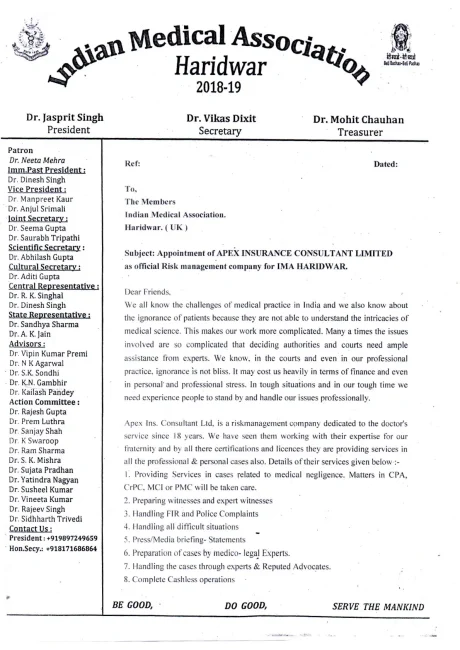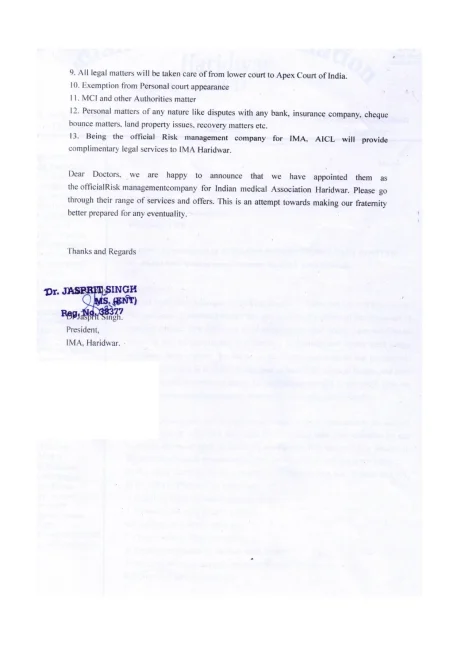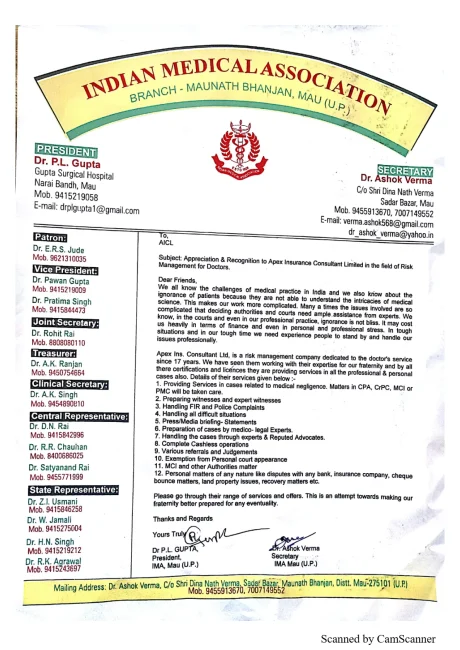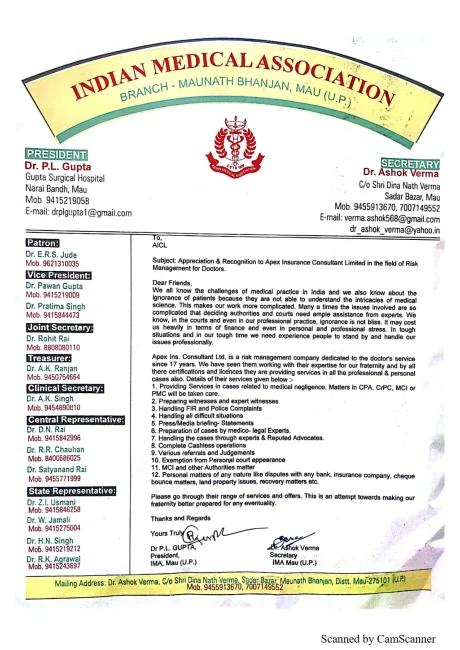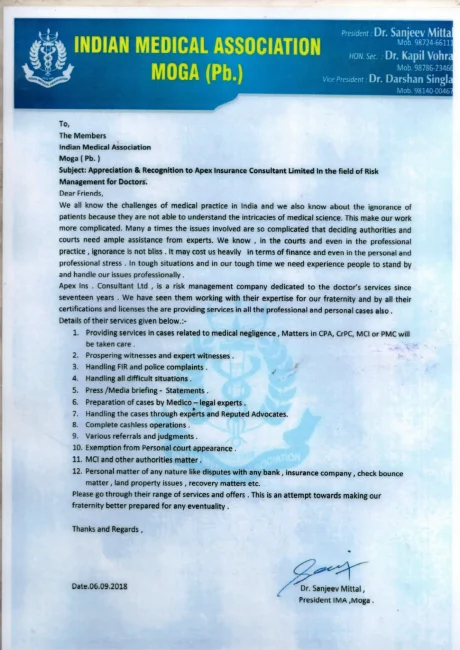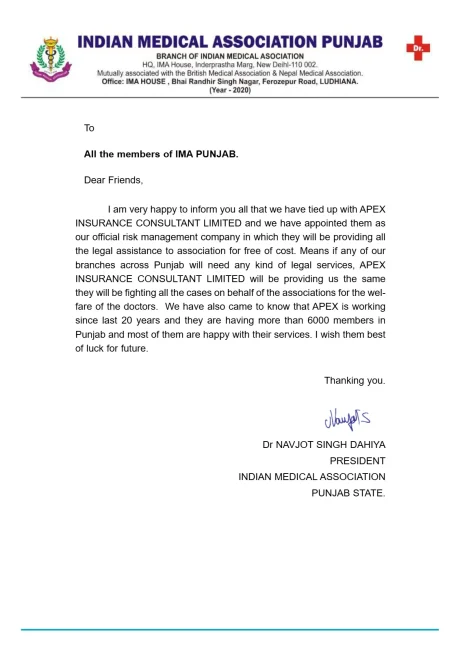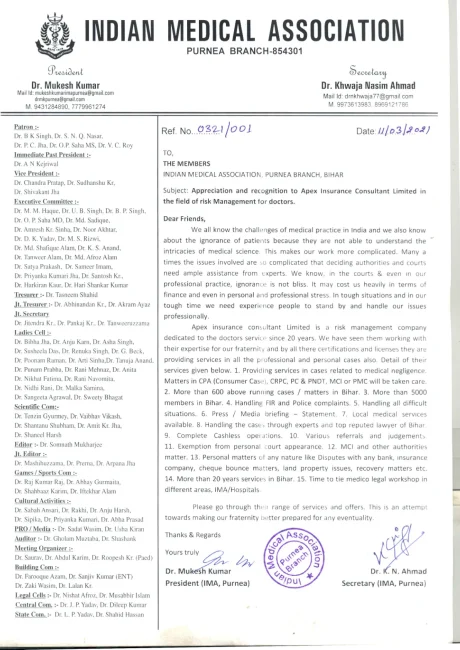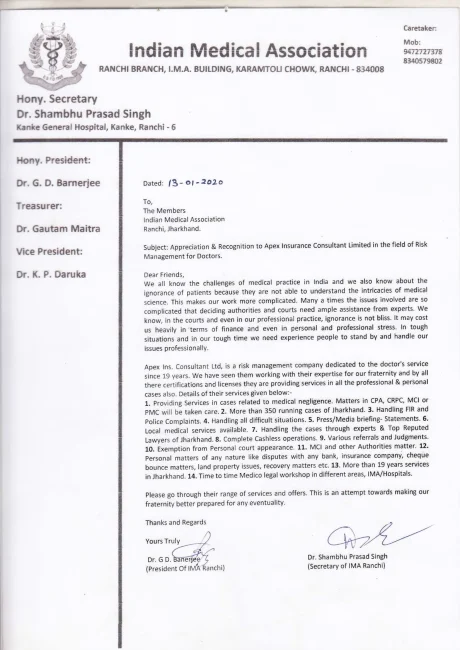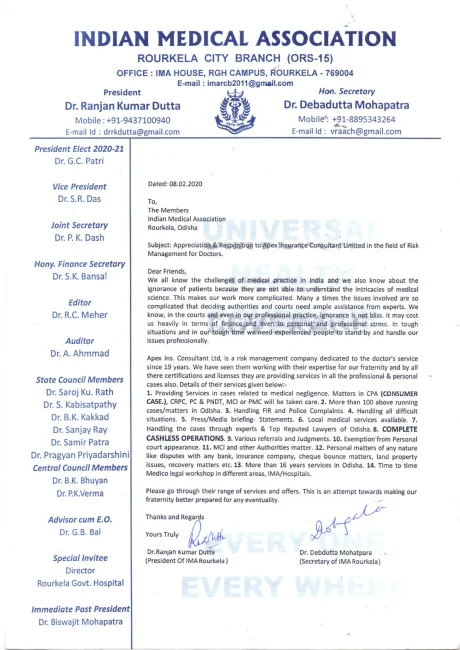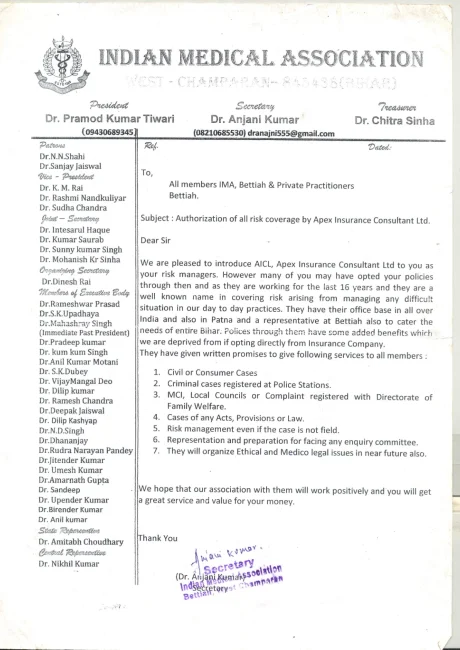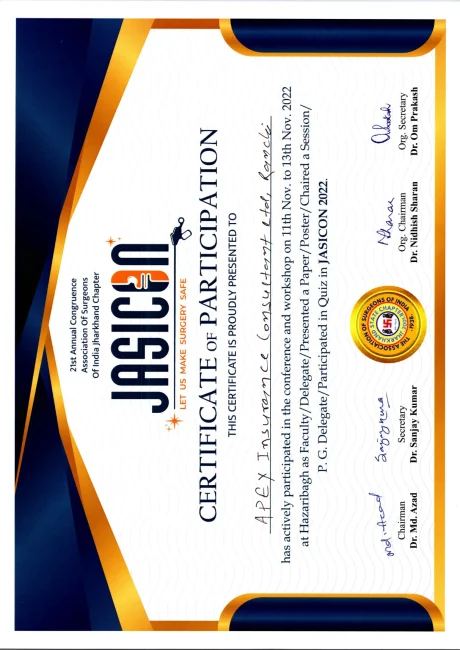Dr. (Prof.) Mahesh Baldwa,
M.D,D.C.H, FIAP, MBA, LL.B,LL.M , Ph. D(law),MBA
SENIOR PEDIATRICIAN & MEDICOLEGAL ADVISOR
Formerly Assistant Professor of Pediatrics at T.N. Medical College and Nair Hospital, Mumbai-400008
Ex. Asst. Professor JJ Hosp, Grant medical college
Ex.Professor, paper setter & examiner of law to postgraduate students of University Department of Law, University of Mumbai
Baldwa Hospital, Sumer Nagar,S.V. Road,
Borivali (West)Mumbai 400 092
Cell 09322990138
INTRODUCTION
Consent should be patient specific, procedure specific, with full disclosure about disease, its investigations and treatment without hiding anything, without misrepresentation, coercion, fraud, undue influence in writing and signed by authorized signatory, which is witnessed by two adult people is good enough.
Informed consent is a process for getting permission before conducting a healthcare intervention on a person. A health care provider may ask a patient to consent to receive therapy before providing it, or a clinical researcher may ask a research participant before enrolling that person into a clinical trial.
Medical Definition of Informed Consent, Assent, Dissent, Forewarning, Refusal of Medical professional Advice
Informed consent means doctor taking relevant information from patient and giving relevant information to patient concerning a particular ailment / problem of patient and parents/guardian.
1. Medical professional take information from patients so it guides them in doing relevant physical examination and if needed relevant investigations.
2. Based on working diagnosis medical professional’s advice drug and / or non -drug treatment prescribed.
3. Therefore a short definition of consent is “doctor agreeing to give Information or advise or warning to patient’s natural parents/ guardians / court who in turn agree with doctor. Such an agreement in legal parlance is consent or risk bond.
4. Assent is one sided, part consent of patient, means agreeing to few advices of doctor and dissent means one sided part disagreement with medical professional advice e.g., patient with inguinal bubo caused by sexually transmitted disease, agrees to drug treatment but disagrees to surgical incision and drainage.
5. Forewarning (currently we use word “counseling”) is needed where patient is likely to spread disease, or likely to commit suicide when HIV positivity is diagnosed.
6. Refusal of treatment by parents of patient needs documentation.
Parties to Consent:
Another major and important thing to do for a doctor is to obtain proper consent of the patient / attendant / relative.
Legal Definition of Consent
The term ‘consent ‘ is defined thus : When two or more persons agree upon the same thing in the same sense they are said to consent as per the definition of ‘consent ‘ given in section 13 of Indian Contract Act, 1872[i]
Condition of Person Who Can Give Consent:
For the purpose of clinical examination diagnosis and treatment consent can be given by any person who is conscious, mentally sound and is above twelve years of age as provided under sections 88 and 90 of the Indian Penal Code, 1860[ii].
Medical professional are reminded that consent is taken under section 13 of the Indian Contract Act, 1872[iii]. This Act, however also provides under Section 11 that only those persons who are above 18 years of age are competent to enter into a contract. Since doctor-patient relationship amounts to entering into a contract, it is advisable that consent should be obtained, specially written consent, from parents / guardian of a patient who is below 18 years so that validity of the contract is not challengeable.
When Consent is not valid:
Consent given under fear, fraud or misrepresentation of facts, or by a person who is ignorant of the implications of the consent, or who is under 12 years of age is invalid (Sec. 90 I.P.C.[iv]).
In most of the cases filed against the medical professional it is alleged that no consent was obtained. Obtaining of consent will thus be a cornerstone of protection against litigation. Depending upon the circumstances in each case consent may be implied, express or informed.
Waiver of the consent
Waiver of the consent requirement may be applied in certain circumstances where no foreseeable harm is expected to result.
1.0 Implied consent (Tacit consent)
This is by far the most common variety of consent in both general practice and hospital practice. The fact that a patient comes to a doctor for an ailment implies that he is agreeable to medical examination in the general sense. This, however, does not imply consent to procedures more complex that inspection, palpation, percussion, auscultation and routine sono-graphy. For other examinations, notably rectal and vaginal and withdrawal of blood for diagnostic purpose, express consent (oral or written) should be obtained. For more complicated diagnostic procedures, e.g., lumbar puncture, radiology, endoscopy, C.T. Scan, etc. express written consent should be obtained.
2.0 Express consent
Anything other than the implied consent is express consent. This may be either oral or written. Express oral consent is obtained for relatively minor examinations or therapeutic procedures, preferably in the presence of a disinterested third party. Express written consent is to be obtained for: (i) all major diagnostic procedures, (ii) general anesthesia, (iii) for surgical operations,(iv) intimate examinations, (v) examination for determining age, potency and virginity, and in medico-legal cases.
3.0 Informed Consent
The concept of informed consent has comes to the fore in recent years and many actions have been brought by patients who alleged that they did not understand the nature of the medical procedure to which they gave consent. All information must be explained in comprehensible non-medical terms preferably in local language about the (a) diagnosis, (b) nature of treatment,(c) risks involved, (d) prospects of success, ( e) prognosis if the procedure is not performed, and (f) alternative methods of treatment. The physician’s duty to disclosure is subject to the exceptions: (a) if the patient prefers not be informed and (b) if the doctor believes in the exercise of coming to a sound medical judgment, that the patient is so disturbed or anxious that the information provided would not be processed rationally or that it would probably cause significant psychological harm. This is known as Therapeutic Privilege. In such a case it is advisable that the doctor should consult the patient’s family physician. Revelation of risk is always a compromise between reasonable information and the danger of frightening off the patient from beneficial treatment. The three important components of such consent are information, voluntariness and capacity.
4.0 Proxy Consent (Substitute consent)
All the above types of consent can take the shape of Proxy Consent. Parent for child, close relative for mentally unsound /unconscious patient, etc.
5.0 Situations where consent may not be obtained
Like in medical emergencies. The well being of the patient is of paramount importance hence medical treatment precedes legal considerations.
Person suffering from a notifiable disease:
In case of AIDS/HIV positive patients, the position in India regarding it is being a notifiable disease or not is not yet clear. However, in England the Public Health (Infectious Diseases) Regulations 1988 extend the provisions of notifiable diseases to AIDS but not to persons who are HIV positive.
Examination of females:
Under Section 53 (1) of the Code of Criminal Procedure[v], a person can be examined at request of the police, by use of force. Section 53 (2) lays down that whenever a female is to be examined, it shall be made only by, or under the supervision of a female doctor.
Situations Requiring Extra Caution
Medical professional should keep in mind certain high-risk situations, which are common causes for medical negligence actions; situations that require extra caution are surgical treatment related to eye, ear spinal cord and brain.
| KEY MESSAGES 1. Informed consent is the legal embodiment of the concept that each individual has the right to make decisions affecting his or her well-being. 2. The law protects the individual’s right to give informed consent by requiring the disclosure of information by the party to whom consent is given. 3. The emergency exception applies in situations where attempting to secure consent could detrimentally delay proper treatment. |
Consent, Risk, Reasonable, Information, Disclosure
Informed consent is the legal embodiment of the concept that each individual has the right to make decisions affecting his or her well-being.
It is generally accepted that individuals should consider — that is, trade-off — the risks and potential benefits flowing from their decisions. To do so, decision-makers must have knowledge of those risks and potential benefits.
The law protects the individual’s right to give informed consent by requiring the disclosure of information by the party to whom consent is given.
6.0 Risk
Risk may be defined as “exposure to a chance of an injury or loss.”[vi]
It embodies two distinct factors:
1.Chance relates to uncertain events — those that are not predictable in any single case,
2. but for which a probability that an event will occur in any one case may be estimated
Medical informed consent law requires the disclosure of the risks of and alternatives to suggested medical procedures to enable patients to make knowledgeable decisions about the course of their medical care.[vii], as under the failure to warn laws, the obligation to inform is placed upon physicians is unclear. Unlike the foregoing laws, however, the consent issue is resolved by looking to what the decision of the reasonable patient at the time of treatment would be.
7.0 Medical Informed Consent
Informed consent law developed from the intentional tort of battery, which protects the individual from an unwanted physical touching of the body by one having neither express nor implied consent of the person touched nor a privilege to do so.
As informed consent became a recognized basis for physician liability, the courts reasoned that any consent based on inadequate information was vitiated by the failure of the physician to disclose.
Lack of informed consent is considered a matter of negligence of the physician to disclose necessary information to patients rather than battery.[viii]
Negligence requires that four elements be established for liability of the defendant:
1 a duty of defendant to meet a particular standard of care;
2 failures to perform that duty;
3 a causal connection between defendant’s failure and plaintiff’s injury; and
4 An injury in fact, that is, one for which monetary compensation is adequate relief.
8.0 Onus of Proof
In order to recover damages for that outcome, the plaintiff must establish the elements of negligence, that: The physician had a duty to disclose particular information to the patient;
Disclosure did not occur; but for the nondisclosure, the tendered procedure would have been refused, and that the tendered procedure was the cause in fact of plaintiff’s injury; and the plaintiff suffered a injury which can be compensated.[ix]
9.0 Standards of Disclosure
There are two dominant approaches to defining the standard of disclosure of information by which the physician’s duty to their patients is measured.[x]
One is to follow the “professional standard,” or peer “accepted risks” requiring a physician to disclose information that other physicians possessed of the same skills and practicing in the same or a similar community would disclose in the same situation.[xi]
Second is to follow “materiality” or “prudent patient” approach[xii]
10.0 Non-disclosure Excused
The courts recognize situations where a physician’s nondisclosure will be excused.[xiii]
When, if a patient is incompetent to make a reasoned decision, then disclosure to the patient may not be required.[xiv]
Under the therapeutic privilege, the physician may withhold information if disclosure would be upsetting or otherwise would interfere with treatment or adversely affect the condition or recovery of the patient.[xv]
Finally, the emergency exception applies in situations where attempting to secure consent could detrimentally delay proper treatment.[xvi]
More generally, physicians need not disclose risks of which the patient is already
aware or risks that are commonly known.[xvii]
11.0 Materiality of Risk Undertaken
The “materiality” says that the physician’s duty to disclose risk information increases as the magnitude of the risk increases.[xviii]
Further, if risks are of severe consequences, e.g., of death or serious disability, is material and should be disclosed independent of the frequency[xix]
“Severe risks (e.g., death, paralysis, loss of eye sight, hearing and any other a sense organ damage) should always be disclosed, even when the probability of occurrence is almost negligible.
Less severe risks, which have a high incidence of occurrence, likewise should always be disclosed.
Nominal risks with little likelihood of occurrence need not be disclosed.”[xx]
Though every one recognizes that frequency of occurrence, as an important component of risk, yet severity of risk though rare cannot be ignored while disclosure to patient.
12.0 Full Disclosure
The courts stress that “full” disclosure.
There are several reasons why full disclosure as a matter of fact is unlikely in medical practice.
First, the number of risks possible from even routine procedures is great.
Second, the burden of identifying small consequence and diminishingly unlikely risks is too great upon the practitioner, and such a listing most likely would seriously impair the resulting choice by the patient.
Indeed, many courts have recognized the bind placed by the law upon the physician, where the disclosure of too much information so as to lead the patient to refuse needed treatment could rise to the level of negligence.[xxi]
13.0 Implications
The obligation to disclose risk information increases with increasing severity of the potential consequences of complications of disease, drug or surgery.
Consent cannot be substituted for carelessness or unskillfulness or rash action of doctor legally speaking for any action for negligence. Consent is the basic document that speaks about medical professional explanation of disease, procedure and risk told to patient. Of course one cannot impose acceptance of unskillfulness and carelessness and risks arising out of non-availability of prescribed standards for carrying out treatment or procedure or surgery.[xxii]
Low risks with trivial complications of disease, drug or operation needs no disclosure.
14.0 Ideal components of Valid Consent
A patient specific, procedure specific, with full disclosure about disease and treatment without hiding anything, without misrepresentation, coercion, fraud, undue influence in writing and signed by authorized signatory which is witnessed by two people is good enough.
potential obstacles to informed consent are
(1) lies, deceit, and partial disclosure,
(2) the patient’s failure to comprehend
Consent Form should at least contain
- Printed Consent form in English can have printed translated version in the local language appended.
- Consent form can also be filled in the local language or the language understood by the patient.
- Printed consent forms must have enough space to fill complete additional information.
- Take the patient party’s signature / initials on every page of the consent form.
- Doctor-in-charge of the patient / principal surgeon / anaesthetist should also sign the consent form.
- Consent form can have suitable directions from the patient indicating names of relatives / attendants whose directions should be followed in case the patient is not in a position to give direction regarding what needs to be done be his /her doctor in case patient is incapacitated to communicate. Patients can fill column / space provided for such direction with full name, address and telephone numbers of such relatives / friends and can also indicate the order of preference amongst them.
Risk explanation/information
- Explain the potential risks to the patient, especially the commonly occurring one and enumerate such risks in the consent.
- Risks having probability of 10% or more must be specifically spelt out to the patient and duly recorded in the consent.
- Answer any specific question raised by the patients about risks and record the same in the consent. Risk involving loss of vision, hearing, mental function, loss of function of limbs and organs must be specified even though the risk may be rare.
Take ‘high-risk consent’ for
i. hemo-dynamically unstable patients/ metabolically unstable patients, patient with electrolyte imbalances, patient in surgical shock, bacteraemia, toxaemia, septicaemia, DIC Serious and complicated nature of surgery/ latest / new – surgical procedures.
- Removing any organ e.g testes, kidney and reason for removal and insist for sending for histo-pathological examination after removing, if done under anaesthesia given by you.
- Removing any limb or finger, eye, hearing organ, teeth
- High risk patients specify and justify medically, scientifically in consent form.
- Proceeding with a surgery / procedure in spite of any abnormal parameter. Record both the abnormality as well as the reasons for proceeding for anaesthesia.
Consent for post mortem
- legally two types of death may need PM,
- PM after natural death, where cause of death is not known
- PM for all unnatural death which includes table death, post operative death.
- if death is natural then the dead body is property of relatives but if unnatural ,death then dead body becomes property of state.
- for PM in natural death consent of nearest relatives [father, mother, son, daughter etc] is required
- PM for unnatural death the consent for PM is not required but information to local police is required
FAQ on PRACTICE POINTS:
Let us have some concrete example.
Q. An adolescent girl becomes pregnant. Now she seeks advice of a gynecologist. What to do?
A. She is minor as per Indian law so not capable of giving consent for Medical termination of pregnancy (MTP) at her own. She must take father / mother for MTP so valid consent can be given. So she has to disclose her pregnancy to parents. Most adolescents do not want to disclose to their parents pregnancy out of wedlock. So she has to lie about her age to doctor performing MTP. Later say if parents or she herself wants to file a case for rape (As per legal definition of rape under Section 375 of Indian Penal code 1860[xxiii], this is a fit case to be registered with police station for rape) against boyfriend then the police will reach to doctor for finding out who signed the consent and if the girl has signed then consent automatically is invalid as per Indian Law. Now doctor is in trouble. The doctor has to defend till the case goes on in Indian court.
Q. Can an adolescent be seen without parental permission?
A. Yes.
Q. Can we promise confidentiality to adolescent?
A. Yes, on all issues except for sexual abuse examination, sterilization, contraception, promiscuity HIV infection and related matters one requires counselling and tactful handling to prevent social stigma and parental wrath before disclosure to parents. One needs to weigh advantage and risk of suicide before disclosing while tackling such situation. Exceptions are where surgical procedures are involved and medical termination of pregnancy as the Indian law considers pregnancy in adolescent as outcome of rape. Rape is an offence under S. 375,376 of Indian Penal code 1860
- What if we find adolescent is engaging in sexual activity has STD HIV or is pregnant?
- Counselling for social support. See benefits of disclosure to parents or authorities. One must prevent suicides, illegal and septic abortions. MTP permitted with parental + adolescent signature and two witnesses.
- How to tackle HIV infected adolescent?
- Treat HIV and counsel to prevent suicide and prevent discrimination in society due to HIV status.
Q. What to do when faced with an adolescent who is raped or sexually molested.
- Inform police; medical professional should submit only medical report and treatment report to police. We may be hauled up for hiding crime under S. 120A,S. 201,S. 212,S. 375,S.376 if pregnant and secured abortion then S.312 to 315 of Indian Penal Code and S. 156 of Criminal Procedure Code by police
Q. What to do when adolescent expresses suicidal tendencies?
- No attempt of suicide and only ideations then refer to psychiatrist. If attempted suicide, inform police. We are medical professional and no law enforcers. We may be hauled up for hiding crime under S. 120A,S. 201,S. 212,S.306 of Indian Penal Code and S. 156 of Criminal Procedure Code by police.
- What to do when adolescent confesses crime?
- Inform police. We are medical professional and no law enforcers. We may be hauled up for hiding crime under S. 120A,S. 201,S. 212 of Indian Penal Code and S. 156 of Criminal Procedure Code by police.
Confidentiality for adolescent patients
Indian
Indian cultural history is very much endorsed by legal philosophy that parents essentially had complete autonomy over their children. Even today we are in “era of parental autonomy” where children were expected to obey parents and are punished by parents or other law enforcers such as the police if disobedience occurred.
A typical English case law that is widely followed in India is of a young girl, not even fifteen years of age, was pregnant as the result of rape. A surgeon, of the highest skill, openly, in one of the London Hospitals, without fee, performed the operation of abortion. He was charged under the Offences against the Person Act, 1861, with unlawfully procuring the abortion of the girl. The jury were directed that it was for the prosecution to prove beyond reasonable doubt that the operation was not performed in good faith for the purpose only of preserving the life of the girl. The surgeon had not got to wait until the patient was in peril of immediate death, but it was his duty to perform the operation if, on reasonable grounds, and with adequate knowledge, he was of opinion that the probable consequence of the continuance of the pregnancy would be to make the patient a physical and mental wreck. The surgeon was found not guilty. [xxiv]
Practice points- Most of the Indian case laws for adolescent ultimately acquit doctor but hassles and corruption prevalent in police department and long drawn out proceedings in law courts hang as Damocles’ sword on the doctor for decades.
WESTERN STANDARDS ABOUT ADOLESCENT LAW:
In west mainly in USA, towards the end of the 19th century, a shift in legal philosophy developed which ushered in the “era of child welfare.” Corollary to that in western world the laws then reflected the concept that children were different from parents and needed to be protected from abusive parents. If a legal guardian abused these privileges, punishment of the adult was then possible. Thus, juvenile courts developed and child labor was controlled. However, minors were still not allowed to make contracts (as medical contracts) of their own in western countries.
LEGAL RIGHTS OF ADOLESCENTS IN WESTERN COUNTRIES
Health care professionals, parents, legal experts and judges have struggled for over two centuries in the United States with the issue of legal rights of adolescents. Many questions have arisen in examining the circumstances under which adolescents can be evaluated and treated without parents’ knowledge and permission. Such a concern extends to other areas, including doing research on youth, dealing with youth who refuse treatment, privacy of medical records and others. Different laws are found in the 50 states in America detailing what youth or “minors” (those under age 21 years) can seek without parent’s knowledge/permission and what does not fall under this umbrella. When laws do exist, they may be vague and interpreted in various ways by those involved with health care of youth. Definition of “the law” tends to be compilation of various statues, Supreme Court rulings or decisions (state and federal) as well as interpretation of law philosophy, which covers areas not always specifically covered by an identified law at the local, state or federal level.
Customs and usage of common law and tradition held that to treat a minor without appropriate parental consent means legally “assault and battery.” Much of this legal philosophy continues today.
In western world particularly USA it has become a very complex issue in the light of various legal cases. In 1967, the “Era of Rights of Minors” began with a path-breaking legal case – In re Gault. This case involved a 15-year old male who was sentenced by a court to several years of institutionalization after being convicted of placing obscene phone calls to a teacher. The boy’s parents brought forth a successful counter-suit, claiming the original trial was not legal since it violated the minor’s rights on various grounds (such as no official legal representative, no cross examination and so forth).
The Danforth case (1976) placed the minors’ rights against the parents’ rights. This case involved adolescent seeking an abortion from a qualified physician. The state court ruled:
“The State may to impose a blanket provision requiring the consent of a parent or person in loco parentis as a condition for abortion of an unmarried minor during the first twelve weeks of her pregnancy… The State does not have the Constitutional authority to give a third party an absolute, and possible arbitrary, veto over the decision of the physician and his patient to terminate the patient’s pregnancy. Minors, as well as adults, are protected by the Constitution and possess Constitutional rights… Any independent interest the parent may have in the termination of the minor daughter’s pregnancy is no more weighty that the right of the competent minor mature enough to become pregnant.”
Western world and particularly USA also feels such issues are quite complex and are far from being resolved, especially the abortion issue. However, it seems clear that youth can give consent for medical treatment in some situations, and do not necessarily have to involve parents in all cases. In general, it is best to involve parents in such matters, but this is not always possible or feasible. A non-official legal concept has emerged over the past generation-the mature minor doctrine. This implies “emancipated” minors may seek and receive some medical treatment without parental approval of knowledge.
However, the interpretation of “emancipation: can be vague and varies according to different criteria which have been used. In general, those over 18 years of age are considered “adults” and allowed to initiate legal contracts (as seeking health care without parent’s permission or knowledge) while those under 18 are under various restrictions.
CONCLUSION
Can we promise confidentiality to adolescent on which issues?
Yes, we can promise for almost everything confidentiality like for most of the drug and non drug treatment, counselling, forewarning, but be careful for promising confidentiality for sexual abuse examination, sterilization, contraception, promiscuity HIV infection and related matters one requires counselling and tactful handling to prevent social stigma and parental wrath before disclosure to parents. One needs to weigh advantage and risk of suicide before disclosing while tackling such situation. Exceptions are where surgical procedures are involved and medical termination of pregnancy as the Indian law considers pregnancy in adolescent as outcome of rape. Rape is an offence under S. 375,376 of Indian Penal code 1860.
Knowledge is power. Ignorance leads to confusion and uncertainty. Confusion and uncertainty breeds tensions and wrong actions Knowing legal issues of consent and confidentiality shall empower you to deal with ticklish issue of adolescent consent and confidentiality with power to tackle law enforcers. So in conclusion it’s worth repeating and reiterating some issues as below:
Following may be legal source of trouble for medical professional while dealing with adolescents, if police is not informed:
- Hiding pregnancy in minor (less than 18 years) girl
- Doing MTP in minor without parental permission/guardian permission/court permission, even doing MTP on a girl posing a major and accompanied by boyfriend as husband.
- Second trimester abortion in a minor girl may pose problem of disposal of foetus. If found in garbage then medical professional may be charged with s. 318 along with s. 312 to 315 of Indian penal code 1860.
- If minor delivers and doctor gives baby to a unfertile/sterile couple without following due procedure of adoption then may be charged with stealing / theft (s. 379) or cheating (s.420) or worse if baby is shown born to unfertile couple and not born to minor girl then s. 302!!!(Murder). Facts and circumstances and statements given to police shall keep on changing IPC section. Mind well all these all non-bailable offences and one need to obtain anticipatory bail under s. 438 of criminal procedure code. Rest of the legal wrangles depends on the whims of police.
Medical professional can do a lot to preserve confidentiality of adolescent without parental knowledge or consent but at the same time when in doubt information to police under S. 154 of criminal procedure code to police should be given without hesitation otherwise be prepared to be hauled up under S. 156 of criminal procedure code. Street-smart planned approach is suggested to support adolescent physically, sexually, mentally and psychologically without evading law. To quote a similar situation as we do in legal parlance “tax planning is not a crime but tax evasion is” Planned adolescent confidentiality without usurping parental and legal authority is the way out but dicey to practice.
KEY MESSAGES ABOUT INFORMED CONSENT AND ADOLESCENT CONFIDENTIALITY
1. Informed consent is the legal embodiment of the concept that each individual has the right to make decisions affecting his or her well-being.
It is generally accepted that individuals should consider — that is, trade-off — the risks and potential benefits flowing from their decisions. To do so, decision-makers must have knowledge of those risks and potential benefits.
The law protects the individual’s right to give informed consent by requiring the disclosure of information by the party to whom consent is given.
2. There are two dominant approaches to defining the standard of disclosure of information by which the physician’s duty to their patients is measured.
One is to follow the “professional standard,” or peer “accepted risks” requiring a physician to disclose information that other physicians possessed of the same skills and practicing in the same or a similar community would disclose in the same situation. Second is to follow “materiality” or “prudent patient” approach
3. The courts recognize situations where a physician’s nondisclosure will be excused. When, if a patient is incompetent to make a reasoned decision, then disclosure to the patient may not be required.
4. Under the therapeutic privilege, the physician may withhold information if disclosure would be upsetting or otherwise would interfere with treatment or adversely affect the condition or recovery of the patient.
5. Finally, the emergency exception applies in situations where attempting to secure consent could detrimentally delay proper treatment.
More generally, physicians need not disclose risks of which the patient is already aware or risks that are commonly known.
6. The “materiality” says that the physician’s duty to disclose risk information increases as the magnitude of the risk increases.
7. Further, if risks are of severe consequences, e.g., of death or serious disability, is material and should be disclosed independent of the frequency
“Severe risks (e.g., death, paralysis, loss of eye sight, hearing and any other a sense organ damage) should always be disclosed, even when the probability of occurrence is almost negligible.
8. Less severe risks, which have a high incidence of occurrence, likewise should always be disclosed.
9. Nominal risks with little likelihood of occurrence need not be disclosed.”
Though everyone recognizes that frequency of occurrence, as an important component of risk, yet severity of risk though rare cannot be ignored while disclosure to patient
10. The courts stress that “full” disclosure. There are several reasons why full disclosure as a matter of fact is unlikely in medical practice. First, the number of risks possible from even routine procedures is great. Second, the burden of identifying small consequence and diminishingly unlikely risks is too great upon the practitioner, and such a listing most would likely seriously impair the resulting choice by the patient.
Indeed, many courts have recognized the bind placed by the law upon the physician, where the disclosure of too much information so as to lead the patient to refuse needed treatment could rise to the level of negligence.
REFERENCES AND BIBLIOGRAPHY
[i] The Indian Contract Act, 1872
[ii] The Indian Penal Code, 1860
[iii] Supra at i
[iv] Supra at ii
[v] The Code of Criminal Procedure,1973
[vi] Morgan, Probing the Question of Technology-Induced Risk, IEEE Spectrum 58, 59 (Nov. 1981).
[vii] Fordham L. Rev ,An Analysis of “Informed Consent”, 1968;36. 639
[viii] Merz & Fischhoff, Informed Consent does not Mean Rational Consent: Cognitive Limitations on Decision-Making, Legal Med,1990:11 J.. 321
[ix] Prosser and Keeton at 189-93.
[x] Hutton v. Craighead, La. Ct. App. 1988: 530 So.2d 101
[xi] Canterbury v. Spence, The most influential decision rejecting the professional standard questioned whether a custom for disclosure in the medical profession truly exists, D.C. Cir. 1972;464 F.2d 772, 783-84
[xii] Canterbury, 464 F.2d at 787.
[xiii] Wis. L. Rev. 1979,413, 487,The “Exceptions” to the Informed Consent Doctrine: Striking a Balance Between Competing Values in Medical Decision Making,.
[xiv] Banks v. Wittenberg, 1978; 82 Mich. 274, 266 N.W.2d 788 Grannum v. Berard, 1967:70 Wash.2d 304, 422 P.2d 812.
[xv] Ball v. Mallinkrodt Chemical Works, 1964: 53 Tenn.App. 218, 381 S.W.2d 563, 568
[xvi] Stafford v. Louisiana State University, La. Ct. App. 1984: 448 So.2d 852.
[xvii] Sagala v. Tavares, 1987: 367 Pa. Super. 573, 533 A.2d 165, allocatur denied, 1988;518 Pa. 626, 541 A.2d 1138
[xviii] Akron L. Rev. 1976:9 609, 615 Strict Liability and Informed Consent: “Don’t Say I Didn’t Tell You Solve”
[xix] Okla. L. Rev. 32 :868, 886-87 (1979). Malpractice: Toward a Viable Disclosure Standard for Informed Consent,
[xx] Collins v. Meeker, 1967:198 Kan. 390, 424 P.2d 488
[xxi] Tarun Kumar Pramanik v. Dr Kunal Chakraborty & Ors. 1995:2:CPR 545 (WB CDRC).
[xxii] Devendra Kumar Sharma v. PGI ,chandigard 2002;1:CPJ 211
[xxiii] The Indian Penal Code, 1860,see supra
[xxiv] Bourne (1938) 3 All ER 615

